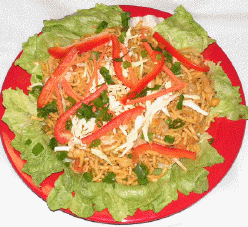CARIBBEAN-CHINESE CONTRIBUTION TO CARIBBEAN CUISINE
October 4, 2007 4:42:00 PM EDT

In Jamaican, Trinidad and Guyana especially, there are large communities of first, second and third generation Chinese immigrants whose culture, like the other ethnic groups have blended into making the culture of the Caribbean regions the most dynamic, exotic, colorful, vibrant and stimulating as well as culturally rich, as evident in the cuisines.
More and more Caribbean-American Restaurants are hyphenating their menu, serving Trinidadian-Chinese, Guyanese-Chinese and Jamaican-Chinese cuisine. This trend is growing and expanding, in some cases, as a means of competing with Chinese-American Restaurants, often found on every block and sometimes right next door to a Caribbean-American Restaurant. However, in most cases, the trend in Caribbean-Chinese cooking is recognition of the dimensions of Caribbean cuisine, an expression of it and a compliment to the Chinese heritage of the Caribbean culture.
The Chinese brought chowmein, lomein, chop suey, sweet and sour chicken and many other exotic dishes to the region and to the Caribbean dining experience when they arrived, and today, these dishes in an ever growing trend, are very much a part of the Caribbean-American culinary and dining experience in the United States.
The method of preparation of many of these Chinese-Caribbean dishes is quite different from the style of preparation in the Far East. The spices and choice of vegetables used in the cooking process of lomein for example, gives it that traditional Caribbean flavor and flair. Trinidadian chowmein is unlike the soupy like version available in Chinese Restaurants, Caribbean style sweet and sour chicken, though similar to the Chinese version, has a slight Caribbean twist to its preparation. The meats are prepared differently, more stewed, less fried, more whole, less diced and shredded.
Caribbean style Chinese chicken fried rice, is usually prepared with the meat on top of the rice, as opposed to being shredded or diced and mixed with the rice. In the preparation of chowmein, another popular Caribbean-Chinese dish, again, the meat is generally served on top of the noodles, undiced and unshredded.
Unlike Chinese-American Restaurants, Caribbean style Chinese foods are not generally served with white rice as a side dish, more emphasis seems to be placed on noodles. The Caribbean-Chinese dishes are spicier accented with thyme, scallions, sweet and hot peppers in addition to the other spices used in Caribbean cooking, and while steamed vegetables are sometimes served with orders, it is not a mainstay as it is on Chinese-American menus.
There are variances in prices, here Chinese-American Restaurants have the edge, an average take-out dinner can still be purchased for under $6 at a Chinese-American restaurant, in a Caribbean-Chinese Restaurant, the average price is $8. Incidentally, the price differential has a lot to do with the way Chinese businesses purchase their products, they do so in bulk, often buying cooperatively in large quantities, thus paying less and therefore are able to pass the savings on to their customers. Caribbean food businesses can learn a thing or two from their Chinese counterparts about cooperative buying.
While Chinese-American Restaurants may hold the edge in the pricing of their foods, the Caribbean-Chinese cuisine hands down is far superior in taste and fulfillment.
Both Chowmein and Lomein (both noodles), are used extensively in Caribbean and Chinese cooking. Chowmein is a finer noodle, made up of egg, Lomein has no egg and is a flatter noodle. Chow- means braised or fried, mein stands for noodles.
The next time you visit a Caribbean-American Restaurant, take a look at their Chinese menu selections, order the vegetable or chicken lomein, you may be pleasantly surprised, in fact, after your wonderful experience, you may be hooked forever on Caribbean style Chinese cuisine.
Posted in News By Karl M. McGowan
